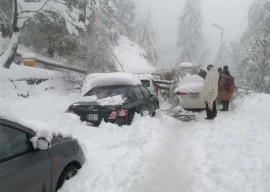The Integrated Master Plan includes three LDA sponsored housing schemes over an area of 45,000 kanals on the Ferozepur Road near Kahna and some 24 private housing schemes. In order to lessen the congestion in the existing business district on Mall Road, the LDA has planned plans two new business districts — one in Johar Town and one proposed for development south of the Hadyara Drain. It is proposed that government offices, banks and educational institutions be shifted to these new business districts. In order to absorb rural-urban migration, the LDA has recommended the establishment of satellite settlements located about 90 minutes away from the periphery of the city.
With 35 per cent of its population living in urban areas, Pakistan is already the most urbanised country in South Asia. Rural to urban migration and high population growth rate mean that in the years to come, the country’s population will double with over half living in its urban areas. The population of Lahore will most probably double within the next two decades. These demographic changes will put stress on available housing, sanitation, employment opportunities, healthcare facilities, educational institutions, recreational areas and transportation options over and above utilities such as water, electricity and gas. The LDA is clearly aware of the changes that are coming inevitable but, is its will the Integrated Master Plan up for meet the challenge?
The Integrated Master Plan appears to prefer the outward sprawl of the city over the redevelopment of older, more congested areas. At present, nearly 65 per cent of Lahore’s population lives in about 10 per cent of its area. The Integrated Master Plan does not appear to focus on where people are. The Plan appears to focus on where people will be twenty 20 years from now. This may have to do with the difficulty in of undertaking redevelopment projects in heavily congested localities with poor property documentation, entrenched business interests and generally, the lack of LDA’s capacity to carry out redevelopment. But sprawl has other costs.
Over and above the increased load on water, electricity and gas utilities because of new inhabitants of the city and stress on sewage and sanitation systems, there are costs and inefficiencies in extending The Grid to new areas. Grid expansion is capital intensive and the homes that consume utilities do so wastefully. Unless the LDA has proper energy and water conservation by-laws in place, with the ongoing energy crisis and threatened water crisis, these new settlements will be a burden rather than a boon.
Sprawl also increases commuting distances. The recent JICA-Transport Department survey of Lahore indicates that 40 per cent of commuters get to work by foot, 44 per cent get to work by motorcycle or public transport and only 8 per cent by car. Until and unless there is adequate public transport and public mobility infrastructure, sprawl will become automobile dependent. Increased automobile usage will add to congestion and pollution and will increase social stratification between those who have access to cars and those who don’t.
Sprawl also has the effect of reducing urban densities. This is, perhaps, the most alarming aspect of the Integrated Master Plan. The essence of cities, their lifeblood, is their ability to give residents freedom to interact with one another. This interaction is the essence of communication, trade, culture and art. It is what makes cities the most incredible of all of man’s achievements. And interaction is best achieved through density. High density mixed-use urban centres are the hallmark of all great cities. Today, London, New York, Paris and Tokyo are looking at means of ensuring public interaction (some through innovative bike-sharing projects). In the past, cities such as Lahore and Delhi also bore characteristics of high density (though their inability to manage sewage often negated the benefit of density). The proposal to create new business districts, while important, will dilute the existing density in the present business district. And relocating important public offices to south of Hudayara Drain will move them miles away from where the majority of the city’s residents already live and work.
The Integrated Master Plan will clearly have impacts on the city’s environment. Under the Pakistan Environment Protection Act, 1997, no such project can be undertaken without a study of these effects or a proposal on how to mitigate them. To date, all but a few urban development plans have gotten the mandatory Environment Approval from the Environment Protection Agencies. Citizens have a right to participate in a hearing of proposed environmental impacts. The LDA should also consider the Report of the Planning Commission’s Task Force on Urban Development and the New Growth Strategy so that they can incorporate their important recommendations into their plans.
Published in The Express Tribune, February 10th, 2012.
COMMENTS (1)
Comments are moderated and generally will be posted if they are on-topic and not abusive.
For more information, please see our Comments FAQ









1732012115-0/Untitled-design-(14)1732012115-0-270x192.webp)





1736332856-0/Untitled-design-(20)1736332856-0-270x192.webp)







I am glad to see Rafay writing for Tribune. I believe , we should go for the highrise model used in advance countries . Instead of the current emphasis on building communities far from the city center let's start building highrises in the center. We should grow our cities vertically rather than horizontally. This way we can cut down on commute, save cost on laying expensive transmission lines over vast distances and also ensure public interaction.